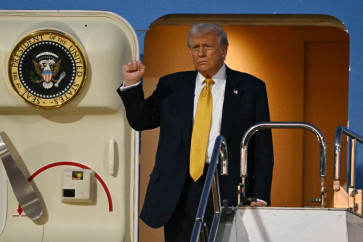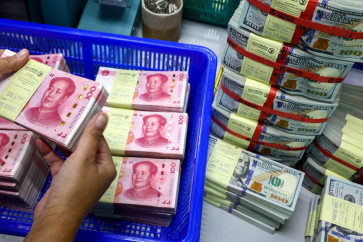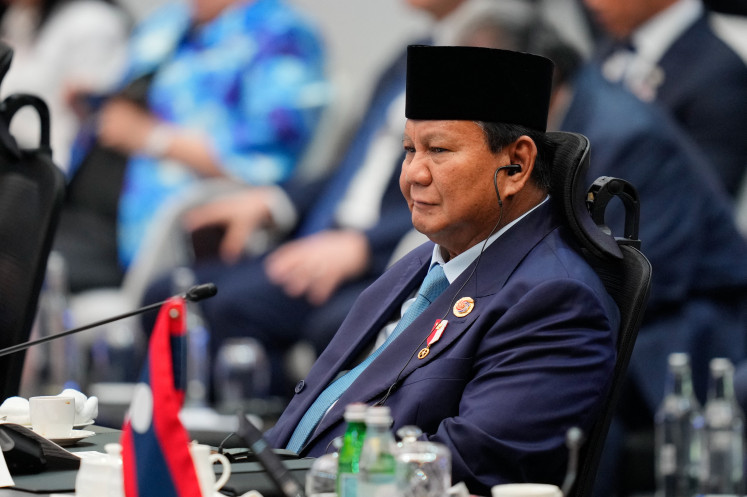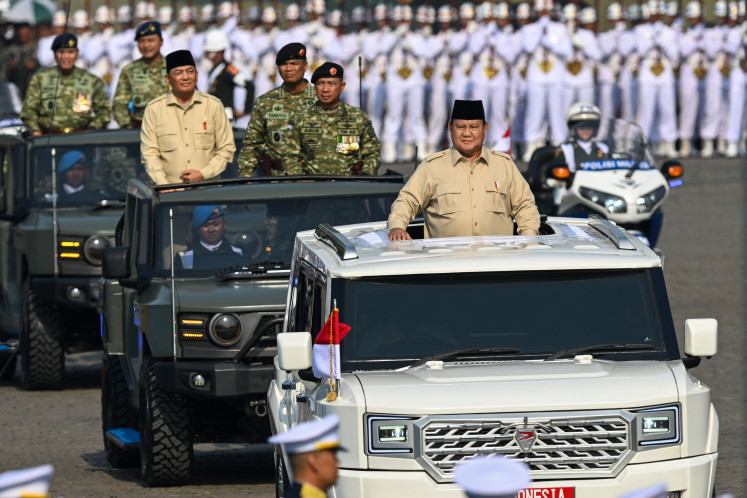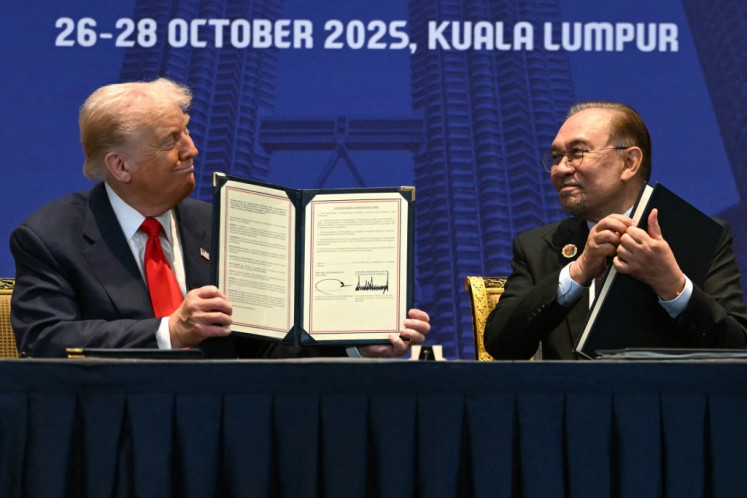Popular Reads
Top Results
Can't find what you're looking for?
View all search resultsPopular Reads
Top Results
Can't find what you're looking for?
View all search resultsSangkot Marzuki: The brilliant professor behind Eijkman
JP/Avril Holderness-RoddamOne of the country's smartest people was once rejected by the prestigious Bandung Institute of Technology (ITB)
Change text size
Gift Premium Articles
to Anyone
JP/Avril Holderness-Roddam
One of the country's smartest people was once rejected by the prestigious Bandung Institute of Technology (ITB).
He went on to study medicine at the University of Indonesia and Thailand's Mahidol University; obtained a PhD from Monash University; and with his research team in Monash, discovered some groundbreaking science, to do with the mutations of the DNA in the mitochondria - one of the important factors in aging and other degenerative diseases.
Meet Professor Sangkot Marzuki, the man behind the prominent molecular biology Eijkman research Institute and chairman of the Indonesian Academy of Sciences.
"It seems like it was written in the sky," he said about his failure to enter ITB. At first, he did not want to study medicine.
"My mother and my grandmother were the ones who wanted me to become a doctor. I defied them and enrolled in ITB's Chemical Engineering," he said. "Maybe it's a parent's blessing I made it to UI's medical studies but not ITB," he said.
His interest in molecular biology surfaced during his studies at UI. After completing his PhD in Biochemistry at Monash in 1975, he settled in Melbourne as a lecturer and researcher in the same university, and continued to live an expatriate life down under for more than 20 years.
Monash awarded Sangkot a higher doctorate in 1998 in recognition of his Magnum Opus on human diseases caused by defective energy metabolism.
"I would still be living in Australia if it were not for Habibie," the 66-year-old said with a smile. In 1992, he returned to Indonesia after former research and technology minister, B.J. Habibie, asked him to lead the country's molecular biology research center.
Despite having returned to Indonesia, Sangkot's still feels strongly connected to Australia. On Jan. 26, 2010, the Commonwealth of Australia made him an honorary member of the order of Australia, the highest recognition for outstanding achievement and service, joining Hartarto Sastrosoenarto, Ali Alatas, Frans Seda and I Made Pastika. Last year, the Indonesian government awarded Sangkot with the Bintang Mahaputra Republik Indonesia.
At the award ceremony on Australia Day, Australian Ambassador to Indonesia Bill Farmer said Sangkot was an outstanding individual and important conduit for links between Australian and Indonesian medical research communities.
Sitting in his rustic office in the historical Eijkman Institute building, Sangkot recounted the story of his return to Indonesia.
On a fateful day in August 1990, he was standing next to a fax machine in the department in Monash University, when the machine made a beeping sound. Back then, fax machines were still a novelty, he said.
"I saw the fax had a Garuda on it," he said, referring to Indonesia's coat of arms, the Garuda Pancasila. Apparently the fax was from Habibie, asking Sangkot whether the former would be able to persuade him to return to Indonesia.
Sangkot's reply to Habibie was: "If it is just about coming back to work in Indonesia, then I would be contributing more to Indonesia by staying at Monash - as at that time I was supervising two PhD students from Indonesia - but if Pak Habibie is interested in something bigger, like opening a molecular biology research like Singapore's IMCB, then I will come home," he said.
Little did Sangkot know that a month prior to sending the fax, Habibie had visited Singapore's Institute of Molecular and Cell Biology (IMCB) and was thinking along the same lines.
Sangkot then returned to Indonesia to discuss the plan with Habibie.
"Habibie knew I had been living abroad for more than 25 years, so he told me to attend the August 17th Independence Day service at the Presidential Palace first before meeting him," he said with a laugh.
His two children, born and raised in Australia, continue to live in the land down under as they have already integrated into the society there. "We had no plans of returning back then, for them it's home," he said.
During his conversations with Habibie, Sangkot proposed to re-activate the Eijkman Institute, which Habibie promptly agreed to.
The current building housing the Eijkman Institute was built under the Dutch colonial rule in 1888 as a laboratory for bacteriology and pathology, after the Dutch physician Christiaan Eijkman found a relationship between the beriberi disease and vitamin deficiency. Eijkman received a Nobel prize for his work.
But in 1965, the prevailing political turmoil interrupted the activities of the institute.
When Sangkot returned to Indonesia in 1992, the Eijkman building was in bad condition and was about to be demolished to make room for a new one.
The professor came to Indonesia without any staff or laboratories. He recruited his PhD students as scientists, and bought equipment. He then proceeded to invite his former PhD students from around Southeast Asia to help carry out research for the Eijkman institute.
Some of his friends from Australia told him that he was crazy for leaving a prestigious and a secure position in Melbourne university to start the Eijkman from scratch, he said.
One man, however, understood why he did it, he remarked. The Australian research biologist Sir Gustav Nossal visited the Eijkman institute in its early establishment. "He understood where we wanted to go from here and asked: *What can I do for you?'" Sangkot said.
Others might have asked for funding for scholarships and fellowships, but Sangkot wanted something different. "I asked him to find me funds to pay six Australian scientists to work here for three years."
Thus started the AIMRI, the Australia/Indonesia Medical Research Initiative. The program worked well until the financial and political crisis in 1998, Sangkot said.
In 1995, less than three years after Sangkot took the helm of Eijkman Institute, 75 scientists were already doing research there.
After the crisis however, the number of scientists had to be cut. With the change in government at that time, future technology was no longer a priority, he said.
Only after the 2004 bombings outside the Australian Embassy did people start to realize the importance of the Eijkman Institute. The scientists there carried out a DNA analysis to identify the bombers. The bomb was so massive that only small tissue pieces of the suicide bomber could be recovered, preventing the use of conventional methods of identification.
As the president of the Indonesian Academy of Sciences (AIPI), Sangkot believes Indonesia's research and development capability will improve over time. There will be more international collaboration in the field of research, especially with America.
In a gathering of around 800 AIPI scientists in January, American Ambassador for Indonesia Cameron Hume read out President Barack Obama's speech highlighting the US increased bilateral cooperation with Indonesia in science education, energy and climate change.
President Susilo Bambang Yu-dhoyono - in his own speech - reinforced his support for the development of science and technology in Indonesia, pledging Rp 1.9 trillion for research and development, almost double 2005's Rp 1 trillion.
"Hopefully, this will bring something good," he said.



